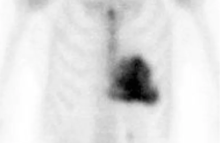A DPD scan is a type of nuclear medicine imaging test which uses radioactive technetium-99m (99mTc) and 3,3-diphosphono-1,2-propanodicarboxylic acid (DPD) to diagnose cardiac amyloidosis. The radiopharmaceutical is taken up only in patients with ATTR amyloidosis, making it a useful tool to differentiate from AL amyloidosis.[1]

DPD is a diphosphonate and can be used as an alternative to HDP or MDP in nuclear medicine bone scintigraphy.[2]
Procedure
editDPD scanning typically uses a gamma camera to obtain SPECT images, with an injection followed by an initial scan after 5 minutes, and a second scan after 3 hours.[3]
Images are often scored using the "Perugini system" whereby:[4][5]
- Grade 0 – no cardiac uptake and normal bone uptake
- Grade 1 – cardiac uptake which is less intense than the bone signal
- Grade 2 – cardiac uptake with intensity similar or greater than bone signal
- Grade 3 – cardiac uptake with much attenuated or absent bone signal
Availability
editDPD is not currently available in the United States.[6]
See also
editReferences
edit- ^ Iskandrian, Ami E.; Garcia, Ernest V. (2015). Nuclear Cardiac Imaging: Principles and Applications. Oxford University Press. p. 543. ISBN 9780199392094.
- ^ Fogelman, Ignac (2012). Bone Scanning in Clinical Practice. Springer. ISBN 9781447114079.
- ^ "Amyloidosis Overview". Centre for Amyloidosis and Acute Phase Proteins. University College London. 22 May 2018. Retrieved 27 June 2019.
- ^ Perugini, Enrica; Guidalotti, Pier Luigi; Salvi, Fabrizio; et al. (September 2005). "Noninvasive Etiologic Diagnosis of Cardiac Amyloidosis Using 99m Tc-3,3-Diphosphono-1,2-Propanodicarboxylic Acid Scintigraphy". Journal of the American College of Cardiology. 46 (6): 1076–1084. doi:10.1016/j.jacc.2005.05.073. PMID 16168294.
- ^ Hutt, David F; Fontana, Marianna; Burniston, Maria; et al. (December 2017). "Prognostic utility of the Perugini grading of 99mTc-DPD scintigraphy in transthyretin (ATTR) amyloidosis and its relationship with skeletal muscle and soft tissue amyloid". European Heart Journal - Cardiovascular Imaging. 18 (12): 1344–1350. doi:10.1093/ehjci/jew325. PMID 28159995.
- ^ Bokhari, Sabahat; Shahzad, Reehan; Castaño, Adam; Maurer, Mathew S. (26 October 2013). "Nuclear imaging modalities for cardiac amyloidosis". Journal of Nuclear Cardiology. 21 (1): 175–184. doi:10.1007/s12350-013-9803-2. PMC 4302756. PMID 24162886.